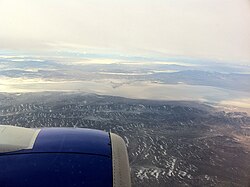Sevier Lake
| Sevier Lake | |
|---|---|

Sevier Lake from an airplane
|
|
| Location |
Millard County, Utah, United States |
| Coordinates | 38°56′20″N 113°09′43″W / 38.93889°N 113.16194°WCoordinates: 38°56′20″N 113°09′43″W / 38.93889°N 113.16194°W |
| Type | intermittent endorheic |
| Primary inflows | Beaver and Sevier rivers |
| Basin countries | United States |
| Surface elevation | 4,550 ft (1,390 m) |
Sevier Lake /sɛˈvɪər/ is an intermittent and endorheic lake which lies in the lowest part of the Sevier Desert, Millard County, Utah. Like Great Salt Lake and Utah Lake, it is a remnant of Lake Bonneville. Sevier Lake is fed primarily by the Beaver and Sevier rivers, and the additional inflow is from the lake's watershed that is part of the Escalante-Sevier hydrologic subregion. The lake has been mostly dry throughout recorded history and is a source of wind-blown dust in dust storms that frequently sweep the Wasatch Front.
The first recorded observation was in 1872, which stated that the lake's surface area was 188 square miles (490 km2), salinity was measured at 86 parts per thousand, two and a half times that of the ocean, and maximum depth was 15 feet (4.6 m). In January 1880 the lake was nearly dry, and had been so for the past one or two years. The Sevier River which once flowed to the lake is now largely diverted for irrigation. In 1987 however, the lake was again similar to the recorded description of 1872.
The Dominguez-Escalante Expedition named it "Laguna de Miera" after a cartographer on their 1776 expedition. In 1825, trappers working for William Henry Ashley trapped the region, and Jedediah Smith named it after him, the Ashley Lake. On some maps, it was named after Joseph Nicollet in the mid-19th century. The lake is currently named for the river, which is derived from "Rio Severo" (wild river [Wild in modern Spanish is Salvaje, or Silvestre]), a local name given by early Spanish explorers.
...
Wikipedia
